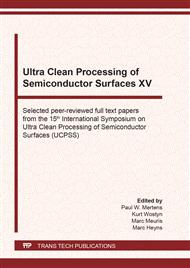[1]
R.R. Schaller, Moore's law: past, present and future, Spectrum, IEEE. 34 (1997) 52–59.
Google Scholar
[2]
J. Shalf, The future of computing beyond Moore's Law, Philos. Trans. R. Soc. A Math. Phys. Eng. Sci. 378 (2020).
Google Scholar
[3]
R.K. Singh, R. Bajaj, Advances in Chemical-Mechanical Planarization, MRS Bull. 27 (2002) 743–751.
DOI: 10.1557/mrs2002.244
Google Scholar
[4]
F.-C. Chang, S. Tanawade, R.K. Singh, Effects of Stress-Induced Particle Agglomeration on Defectivity during CMP of Low-k Dielectrics, J. Electrochem. Soc. 156 (2009) H39–H42.
DOI: 10.1149/1.3005778
Google Scholar
[5]
S. Armini, C.M. Whelan, M. Moinpour, K. Maex, Copper CMP with Composite Polymer Core–Silica Shell Abrasives: A Defectivity Study, J. Electrochem. Soc. 156 (2009) H18–H26.
DOI: 10.1149/1.2994631
Google Scholar
[6]
Y. Li, Y. Liu, C. Wang, X. Niu, T. Ma, Y. Xu, Role of Dispersant Agent on Scratch Reduction during Copper Barrier Chemical Mechanical Planarization, ECS J. Solid State Sci. Technol. 7 (2018) P317–P322.
DOI: 10.1149/2.0101806jss
Google Scholar
[7]
N.P. Yerriboina, S. Sahir, S.-Y. Han, K.-M. Han, J.-G. Park, The Adhesion and Removal Mechanism of Ceria Particles for STI Post-CMP Cleaning Process, ECS Trans. 92 (2019) 157–164.
DOI: 10.1149/09202.0157ecst
Google Scholar
[8]
S. Brems, M. Hauptmann, E. Camerotto, A. Pacco, T.G. Kim, X. Xu, K. Wostyn, P. Mertens, S. De Gendt, Nanoparticle removal with megasonics: A review, ECS J. Solid State Sci. Technol. 3 (2014).
DOI: 10.1149/2.004401jss
Google Scholar
[9]
R.K. Singh, C. Patel, D. Trio, E. McNamara, C. Wargo, PVA Brush Technology for Next Generation Post-CMP Cleaning Applications, ECS Trans. 33 (2010) 167–173.
DOI: 10.1149/1.3489057
Google Scholar
[10]
Y.-K. Hong, D.-H. Eom, S.-H. Lee, T.-G. Kim, J.-G. Park, A.A. Busnaina, The Effect of Additives in Post-Cu CMP Cleaning on Particle Adhesion and Removal, J. Electrochem. Soc. 151 (2004) G756–G761.
DOI: 10.1149/1.1802493
Google Scholar
[11]
Y. Sampurno, Y. Zhuang, X. Gu, S. Theng, T. Nemoto, T. Sun, F. Sudargho, A. Teramoto, A. Philipossian, T. Ohmi, Effect of Various Cleaning Solutions and Brush Scrubber Kinematics on the Frictional Attributes of Post Copper CMP Cleaning Process, Solid State Phenom. 145–146 (2009) 363–366.
DOI: 10.4028/www.scientific.net/ssp.145-146.363
Google Scholar
[12]
X. Gu, T. Nemoto, A. Teramoto, T. Ito, T. Ohmi, Effect of Additives in Organic Acid Solutions for Post-CMP Cleaning on Polymer Low-k Fluorocarbon, J. Electrochem. Soc. 156 (2009) H409–H415.
DOI: 10.1149/1.3106106
Google Scholar
[13]
J.C. Yang, H. Kim, D.W. Oh, J.H. Won, C.G. Lee, T. Kim, Experimental evaluation of the effect of pad debris size on microscratches during CMP process, J. Electron. Mater. 42 (2013) 97–102.
DOI: 10.1007/s11664-012-2334-9
Google Scholar
[14]
Y. Ein-Eli, D. Starosvetsky, Review on copper chemical-mechanical polishing (CMP) and post-CMP cleaning in ultra large system integrated (ULSI)-An electrochemical perspective, Electrochim. Acta. 52 (2007) 1825–1838.
DOI: 10.1016/j.electacta.2006.07.039
Google Scholar
[15]
C.F. Graverson, K.M. Wortman-Otto, A.N. Linhart, T.B. Zubi, J.J. Keleher, Development of Soft, Cleaning Chemistries for Enhanced STI Post-CMP Cleaning, ECS Trans. 92 (2019) 165–174.
DOI: 10.1149/09202.0165ecst
Google Scholar
[16]
D. Ng, S. Kundu, M. Kulkarni, H. Liang, Role of Surfactant Molecules in Post-CMP Cleaning, J. Electrochem. Soc. 155 (2008) H64–H68.
DOI: 10.1149/1.2806173
Google Scholar
[17]
G. Zhang, G. Burdick, F. Dai, T. Bibby, S. Beaudoin, Assessment of post-CMP cleaning mechanisms using statistically-designed experiments, Thin Solid Films. 332 (1998) 379–384.
DOI: 10.1016/s0040-6090(98)01038-4
Google Scholar
[18]
Prosys, Prosys Product Systems Inc., ProSys. (2020). https://www.prosysmeg.com/ Megasonics-Cleaning.html.
Google Scholar
[19]
E. Camerotto, S. Brems, M. Hauptmann, J. Lurquin, H. Struyf, P. Mertens, S. De Gendt, Towards an improved megasonic cleaning process: influence of surface tension on bubble activity in acoustic fields, Solid State Phenomena. Vol. 195 (2013) pp.173-176.
DOI: 10.4028/www.scientific.net/ssp.195.173
Google Scholar
[20]
H. Wondraczek, A. Kotiaho, P. Fardim, T. Heinze, Photoactive polysaccharides, Carbohydr. Polym. 83 (2011) 1048–1061.
DOI: 10.1016/j.carbpol.2010.10.014
Google Scholar
[21]
J. Sun, H. Tan, Alginate-based biomaterials for regenerative medicine applications, Materials (Basel). 6 (2013) 1285–1309.
DOI: 10.3390/ma6041285
Google Scholar
[22]
T.A. Davis, B. Volesky, A. Mucci, A review of the biochemistry of heavy metal biosorption by brown algae, Water Res. 37 (2003) 4311–4330.
DOI: 10.1016/s0043-1354(03)00293-8
Google Scholar


